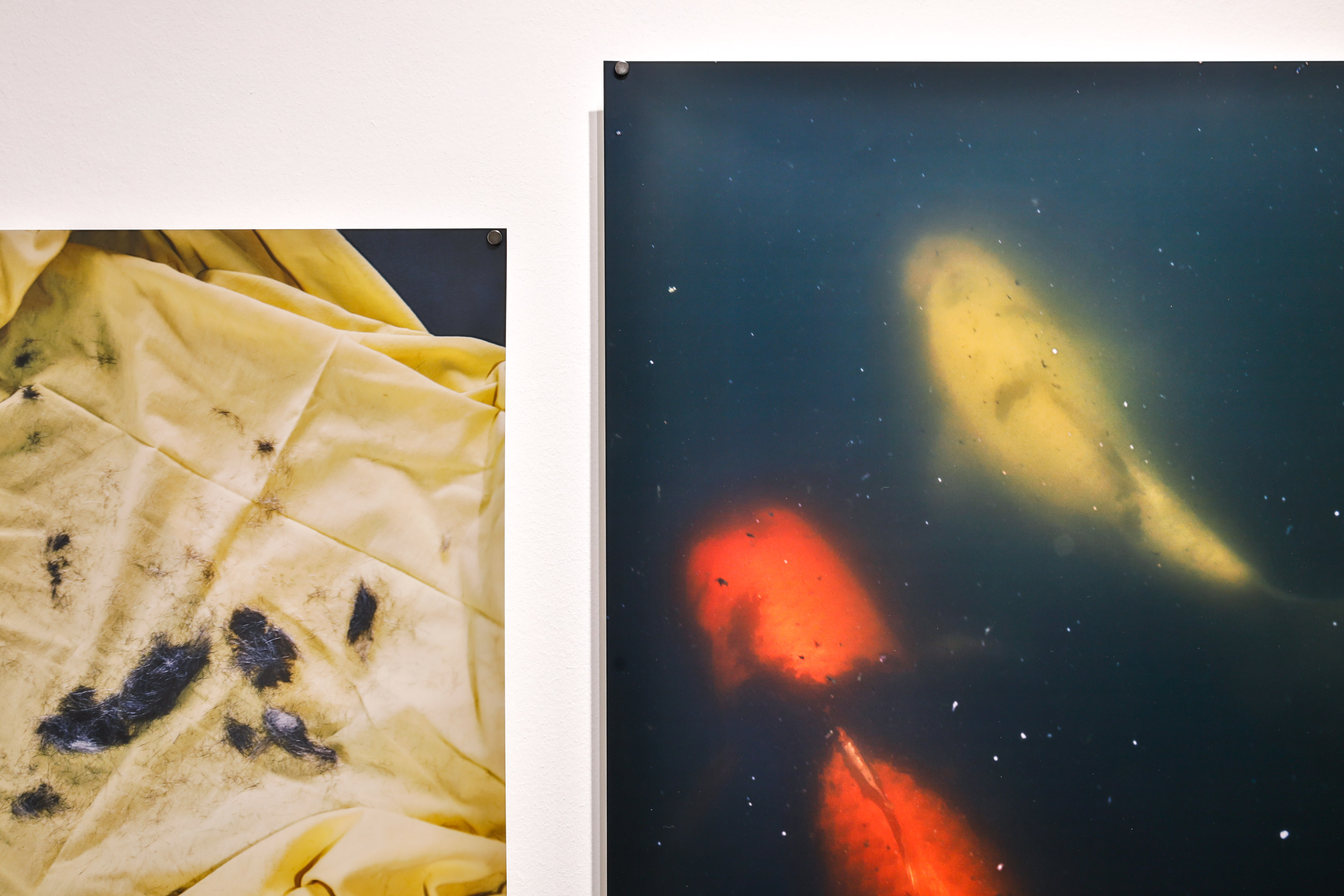Exhibition
HAUSARREST - Julia Lormis
Photographic (re)observations of the banal everyday life in isolation
Her photographs are snapshots whose subjectivity coincides with the greatest possible objectivity. The ordinary and the familiar are honored through controlled camera angles, selective depth of field or blurring, or rhythmic image combination, and at the same time raise questions about the relationship between reality and fiction. In this multi-layered narrative character between art and documentation, the individual image retains its independent quality and has a mutually reinforcing effect in serial montage. Her photographs are images that have the pretension of a "painting" in format, colour and composition.
Pointed expression of traditional genre motifs across all borders
The exhibition "HAUSARREST" extends the conceptual approach of the photographic essay "HAUSARREST" (2020) to the spatial level. The walk-in, audiovisual room installations of the living room (first room of the Art Lounge) and the kitchen (second room of the Art Lounge) point to the Dutch genre painting of the 17th century in a contemporary form, in that the viewer can voyeuristically look into the room from the outside, as well as actually enter the private room, the "artist's studio“. The border between "public" and "private" becomes blurred.
The audio playbacks serve as counterparts to the photographic works. The television address by German Chancellor Angela Merkel at the beginning of the first lockdown phase in March 2020 marks the temporal beginning of the photographic works. With Albert Camus' "The Plague" and Giovanni Boccaccio's "The Decameron", being confronted with oneself is linked in a historical-literary context. In the audio sequences, people from all over the world talk about their thoughts, impressions or experiences during the isolation. Julia Lormis combines this global, historical, literary "storytelling" and her photographs to create a complex work of art.
Corona diaries I & II - thoughts, impressions and experiences during the isolation
Lockdown stand still versus inward mobility
Through the stage-like, narrative, spatial orchestration, Julia Lormis makes the viewer remember his or her own experiences and connect them with the photographs or spatial impressions shown. In this way, she succeeds not only in visualizing present-day events and the following basic questions of human life, such as loneliness, fears, but also hope and confidence, but also in making them a topic of conversation. She decodes and encodes the visible. Her works create a place in the visual memory.
Poetic-documentary interplay between abstraction and realism
The realism of her photographs is based on the pictorial aesthetics and clarity of the subject and is particularly characterized by the precise observation of light and shadow as well as the resulting differentiated colorfulness. This creates representations that are on the one hand precise, on the other hand abstracted. In their factual precision, the motifs display sculptural qualities. In the abstract interplay of surfaces and structures, formal boundaries are suspended and references to the informal painting of the 1960s become visible.
Corona diaries III
Still life as a docking station for viewers
In the photographs, which relate to still lives, the motifs do not move. This lack of movement corresponds figuratively to the artist's life situation at the time of the photograph. The only freedom was in the choice of the motif and its reproduction.
The tension between cheerful-humorous and thoughtful-contemplative, between superficial simplicity and multi-layered compression, which is characteristic for Julia Lormis' works, breaks up the speechlessness of the situation. The audiovisual room installation thereby breaks the mold of the traditional concept of art.
With this exhibition, Julia Lormis uses artistic means to document a situation that every visitor is likely to have experienced in a similar form. Her artistic work combines topicality with a high degree of general validity.
Reading direcly from the HAUSARREST living room
On Thursday, February 4, at 6:30 p.m. Achim Lenz, artistic director of the Gandersheimer Domfestspiele, will read passages from the novel " The Plague" by Albert Camus directly from the "HAUSARREST Living Room".
Stay excited!
Here you can follow the event live on February 4 and / or watch a summary with an exhibition tour via video at a later date. The complete stream is availabe till the end of February.
Summary with greetings from the KWS Board Member Eva Kienle
This text was written by art historian Ulla Feiste.
You are welcome to gain exciting insights into our exhibition directly on site, even during this pandemic. Stop by and take a look through our display windows.
HAUSARREST - Julia Lormis
From 15 January 2021
KWS Art Lounge NEWCOMER
Tiedexer Straße 20, 37574 Einbeck
With digital book to the exhibition HAUSARREST
About the artists - Julia Lormis & Ulla Feiste
Photographer Julia Lormis
She (* 1993), winner of the Andreas Art Award 2020, has been working as a freelance photographer since 2012. Her works are in the fields of photography, mixed media, video art and installation. The focus of her commissioned and freelance works is mainly "man and the environment", always going beyond the purely illustrative approach to artificial photography, from single images to series, from two-dimensional expression to three-dimensional multimedia installation. In this interesting range, the artist develops a photojournalism with an artistic-documentary approach, in which socio-political discourses are negotiated.
Art historian Ulla Feiste
She lives and works in southern Lower Saxony. She studied art history at the Rijksuniversiteit in Groningen, the Netherlands. As an art teacher, lecturer and curator she works for different institutions.
Her concern is to convey to children, young people and adults the manifold expressions of visual art in the field of tension between tradition and innovation.
Discover more
Your contact



















